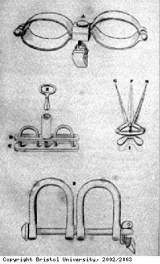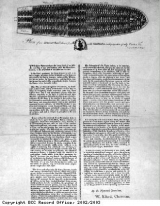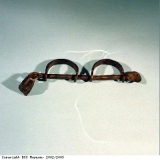The Middle Passage
The Middle Passage was the crossing from Africa to the Americas, which the ships made carrying their ‘cargo’ of slaves. It was so-called because it was the middle section of the trade route taken by many of the ships. The first section (the ‘Outward Passage’ ) was from Europe to Africa. Then came the Middle Passage, and the ‘Return Passage’ was the final journey from the Americas to Europe. The Middle Passage took the enslaved Africans away from their homeland. They were from different countries and different ethnic (or cultural) groups. They spoke different languages. Many had never seen the sea before, let alone been on a ship. They had no knowledge of where they were going or what awaited them there.
The slaves were packed below the decks of the ship. The men were usually shackled together in pairs using leg irons, or shackles. Some leg irons are pictured here. The men were considered dangerous, as they were mostly young and strong and likely to turn on their captors if the opportunity arose. People were packed so close that they could not get to the toilet buckets, and so lay in their own filth. Seasickness, heat and lack of air all contributed to the terrible smell. These conditions also encouraged disease, particularly fever and the ‘bloody flux’ or gastroenteritis (a serious stomach bug). The voyage usually took six to eight weeks, but bad weather could increase this to 13 weeks or more. This engraving (a type of print) of the slave ship the Brookes, from Liverpool, shows the slaves packed into the hold of the ship. It shows 295 enslaved Africans, this was the legal number the ship could carry after a change in the law. The Dolben Act of 1788 regulated the number of slaves according to the size of the ship. On a previous voyage the Brookes had carried 609. If you look carefully at the Brookes picture, you can see the leg irons shackling the men together at the ankle.
There are a very few accounts of the Middle Passage, written by enslaved Africans who had experienced conditions on a slave ship at first-hand. This was because many Africans who made the crossing would not have known how to write, or had the chance to learn later in life. One well known African writer who did experience the crossing wrote, was Olaudah Equiano. He wrote, ‘The shrieks of the women and the groans of the dying, rendered the whole a scene of horror almost inconceivable’, in his autobiography The Interesting Narrative…, published in 1789. For many on the terrible crossing, death was preferable to the unknown fate awaiting them. Ottobah Cuguano, an African man who was enslaved in about 1770, planned with his fellow slaves to blow up the ship and all die together. Their plan failed.
A few ships crossed the Middle Passage without any deaths. Some ships lost most of their ‘cargo’. The average losses were between 10 and 20%, through sickness, suicide and even murder at the hands of the slave crew and captains. 10% means over 1,000,000 Africans died on board the ships, 20% represents over 2,000,000 deaths.





